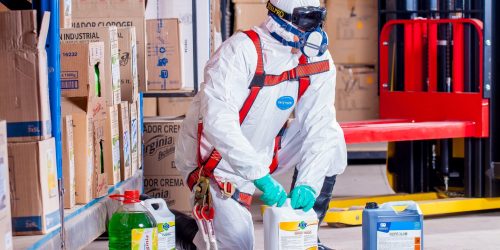Purchasing guide: Disinfecting your workplace to prevent winter viruses
Since the start of the current health crisis, purchases of cleaning products have skyrocketed. Cleaning and disinfection measures in the workplace have been stepped up to ensure the health and safety of all. But choosing the right product, deciding on the right frequency of use, and ensuring that the premises are disinfected effectively is not an easy task. Find out about good cleaning practices to follow and minimise the environmental transmission of winter viruses in your workplace.
What does workplace disinfection involve?
For a successful workplace disinfection policy, it is essential to understand the difference between the various types of cleaning products available on the market:
- Detergents;
- Disinfectants.
Whether they are intended for use by cleaners or for hygiene purposes, detergents and disinfectants each have their role to play. The combination of the solutions is essential to remove the risk of contamination by viruses in winter time.
Detergents
It is not possible to disinfect effectively without cleaning beforehand. Using a cleaning product before disinfecting a surface is therefore essential.
Disinfectants
Cleaning removes 80% of micro-organisms. To deal with the remaining 20% and keep the workplace healthy, using a disinfectant, for example, bleach is necessary.
To make sure that a disinfectant is effective against viruses, check that it complies with the virucidal standard NF EN 14476.
Determine your workplace cleaning and disinfection needs
Before making a shopping list of new equipment to get, it is essential to determine the cleaning products you need according to the type of premises and the hardness of the running water.
The type of premises
The products to use and the frequency of cleaning are not the same in a kitchen as in an office space. For your company, start by determining which risk zone each site corresponds to.
For example:
- Offices, meeting rooms and movement areas correspond to a zone 1;
- Dining areas to a zone 2;
- Toilets, showers, or kitchens to a zone 3.
Depending on the type of zone, the rules for cleaning and disinfecting are not the same. All of them require cleaning of points of contact (door handles, handrails, etc.), as well as damp sweeping the floors daily. However:
- In zone 1 areas, floors can be mopped once a week and workplace disinfection is not required apart from the points of contact;
- In zone 2 areas, floors must be mopped daily and workplace disinfection is required once a week;
- In zone 3 areas, it is necessary to mop the floors and to disinfect daily.
It is also essential to consider the types of work surfaces being cleaned. Cleaners do not use the same products on carpets, parquet, or tiles.
Finally, regardless of the zone, it is important to ventilate areas regularly in order to promote the exchange of air, an essential step in preventing viruses from spreading.
Water hardness
The hardness of water indicates the amount of limescale it contains, measured in parts per million (PPM). The higher the PPM, the harder the water is.
Limescale interferes with the effects of cleaning products. For very hard water, a sequestering agent should be used to trap the limescale and, in some cases, cleaning may have to be performed more frequently.
Think about the cleaning equipment
The equipment used by cleaners should not be forgotten. When calculating the number of cleaning trolleys needed, the size and risk zones of the workplace should be taken into consideration.
Discover all the brooms and cleaning accessories available on the Manutan website. As a promoter of ‘Well-working’ in companies, we prioritise ergonomic equipment. As well as helping to prevent the risk of MSDs (musculoskeletal disorders), it allows cleaners to work more efficiently.
Understand the different types of cleaning products
There are many products available for workplace disinfection and health protection.
Cleaning products
These are used for cleaning and disinfecting surfaces, contact points and floors in various workplaces. There are ready-to-use formulas or formulas to be diluted with water. We recommend a combination product to clean and disinfect in one go.
A multi-surface disinfectant cleaner makes it possible to clean and disinfect the workplace with a single product. Compliant with NF EN 14476, it guarantees the elimination of viruses if used correctly.
For toilets, it is recommended to opt for a descaling disinfectant that combines cleaning, descaling, and disinfecting, specially designed to effectively eliminate both limescale and viruses.
For food surfaces, a disinfectant detergent with a formula specially designed for this type of use should be chosen. This combination product is particularly suited to your company’s kitchens and helps to control the spread of virus infections.
Browse the Manutan catalogue for all the cleaning products available.
Hygiene products
These are essential for completing the workplace disinfection and therefore reducing the risks of people spreading and transmitting viruses.
Soap for industrial use
Soap for industrial use is intended for professionals who perform manual work exposed to external aggressors. This is the case, for example, in the construction, logistics and industrial sectors, but also for hairdressers and mechanics.
In offices where only tertiary sector companies are present, this type of soap, capable of removing stubborn oil, glue, grease, or tar stains, may not be needed.
A microbead washing gel allows you to clean and degrease effectively, without damaging and drying out the skin.
In areas without access to water, it is important to provide staff with cleaning wipes to protect the health and safety of all.
Discover our selection of soaps for industrial use.
Soap for everyday use
For the toilets at your workplace, you must include soap for everyday use so people can wash their hands. A gentle, skin-friendly formula that is free of toxic substances is the ideal solution for protecting health at work.
Check out our selection of everyday use soaps and soap dispensers. Transparent to check the fill level, contactless for maximum hygiene or stylish for modern decor… we offer a wide range of products for companies.
Hand sanitiser
Hand washing with water on a regular basis is not always possible in the workplace. To overcome this problem, employers should provide employees with hand disinfectant gel. It must contain at least 60% alcohol for an effective anti-bacterial and anti-viral effect. This is an essential step in limiting the spread of any virus or infection and completes workplace disinfection.
At the entrance to the dining area, in the reception area, next to the coffee machines… Consider providing a gel dispenser to allow everyone to disinfect their hands regularly and effectively.
Discover our range of hand sanitiser gel and our hand sanitiser gel dispensers.
To find out more, read our purchasing guide for hygiene and cleaning products.
Avoid the hazards of cleaning and disinfection products
Cleaning products contain chemicals that are sometimes dangerous for the health of their users and the environment. To reduce the risks, it is essential to observe their conditions of use as well as storage.
Hazard pictograms
Hazard pictograms provide valuable information on the toxicity of a cleaning or disinfection product. Reading and understanding these directions is crucial for the proper use and safe storage of these products as well as their proper disposal once they become waste.
In the Manutan catalogue, each product page contains a dedicated safety data sheet (SDS).
This sheet must be consulted with care. In particular, it indicates:
- Information on hazardous components;
- Emergency response measures to take in case of accidental dispersal;
- Handling and storage conditions;
- Toxicological and ecological information;
- Disposal guidance.
Cleaners should be trained in the use, storage, and disposal of each product. With proper use, it is possible to protect the health of all.
Companies are therefore advised to have a storage cabinet for hazardous products and to ensure that incompatible formulas are never stored together.
Finally, employers must provide PPE (Personal Protective Equipment) such as cleaning gloves or goggles to employees handling hazardous products or waste.
Protecting the environment
In order to reduce the risks associated with products that are potentially dangerous for employees and the environment, there are formulas that are both eco-friendly and effective in workplace disinfection.
Labels
You can see whether a product is eco-friendly by checking its labels. These are always clearly indicated on the Manutan website.
In terms of hygiene and cleaning, 3 main labels certify the eco-friendliness of a formula:
- The European Ecolabel;
- Cradle To Cradle;
- Nordic Swan.
These labels certify that the formulas meet certain standards in terms of their impact on the environment and health.
The choice of products
For the effective workplace disinfection, the range of eco-friendly and sustainable formulas is still not very extensive.
Disinfecting your workplace will now be a breeze. To find out more, see our “Hand hygiene” category.





